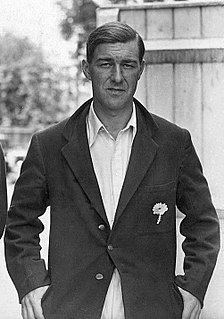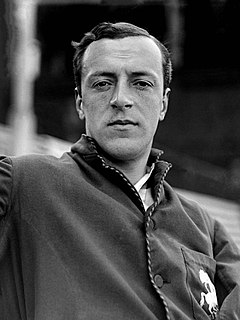Related Research Articles

Sir John Berry Hobbs, always known as Jack Hobbs, was an English professional cricketer who played for Surrey from 1905 to 1934 and for England in 61 Test matches between 1908 and 1930. Known as "The Master", he is widely regarded as one of the greatest batsmen in the history of cricket. He is the leading run-scorer and century-maker in first-class cricket, with 61,237 runs and 197 centuries. A right-handed batsman and an occasional right-arm medium pace bowler, Hobbs also excelled as a fielder, particularly in the position of cover point. Hobbs was named as one of the five Wisden Cricketers of the Century alongside Sir Donald Bradman, Sir Garfield Sobers, Shane Warne, and Sir Viv Richards.

Norman Walter Dransfield Yardley was an English cricketer who played for Cambridge University, Yorkshire County Cricket Club and England, as a right-handed batsman and occasional bowler. An amateur, he captained Yorkshire from 1948 to 1955 and England on fourteen occasions between 1947 and 1950, winning four Tests, losing seven and drawing three. Yardley was named Wisden Cricketer of the Year in 1948 and in his obituary in Wisden Cricketers' Almanack, he was described as Yorkshire's finest amateur since Stanley Jackson.
Gentlemen v Players was a long-running series of English first-class cricket matches, between teams consisting of amateur (Gentlemen) and professional cricketers (Players).

When the First World War ended in November 1918, thousands of Australian servicemen were in Europe as members of the First Australian Imperial Force (AIF) and many remained until the spring of 1919. In England, a new first-class cricket season was planned, the first since 1914, and an idea that came to fruition was the formation of an Australian touring side made up of servicemen. Agreement was reached with the Australian Corps HQ in London, commanded by Field Marshal William Birdwood, 1st Baron Birdwood, and the Australian Imperial Force Touring XI was formed, initially under the captaincy of pre-war Test player Charlie Kelleway. Kelleway departed after only six matches following a dispute about the fixtures list. A players' meeting elected future Test player Herbie Collins as team captain for the remainder of the tour, despite the fact that Collins' military rank was lance corporal and there were seven officers in the party. The bulk of the team remained intact for nearly nine months from May 1919, playing 33 matches in Great Britain, ten in South Africa on their way home and then another three in Australia itself before disbanding in February 1920. Of the 46 matches, 39 are adjudged first-class and the team had only four defeats, all of these in England. The players lived on their army pay and all profits from gate money went to an AIF Sports Control Board.
An England team toured Australia between November 1920 and March 1921. The tour was organised by the Marylebone Cricket Club and matches outside the Tests were played under the MCC name. The tour itinerary consisted of 13 first-class matches, including a series of 5 Test matches against Australia in which The Ashes were at stake.
The England cricket team toured Australia and New Zealand between October 1962 and March 1963 with a one-match stopover in Colombo, en route to Australia. The tour was organised by Marylebone Cricket Club (MCC) and, in all matches other than Tests, the team was called MCC. In Australia, the tour itinerary consisted of 15 first-class matches, including the five-match Test series against Australia in which The Ashes were at stake.
1947 was the 48th season of County Championship cricket in England. It is chiefly remembered for the batting performances of Denis Compton and Bill Edrich who established seasonal records that, with the subsequent reduction in the number of first-class matches, will probably never be broken. Their form was key to their team Middlesex winning the County Championship for the first time since 1921, although they were involved in a tight contest for the title with the eventual runners-up Gloucestershire, for whom Tom Goddard was the most outstanding bowler of the season. Compton and Edrich were assisted by the fact that it was the driest and sunniest English summer for a generation, ensuring plenty of good batting wickets.
1962 was the 63rd season of County Championship cricket in England.
William "Bill" Harrington was an Irish cricketer. A right-handed batsman and off spin bowler, he played 28 times for the Ireland cricket team between 1894 and 1921, including fifteen first-class matches.
The New Zealand cricket team toured England in the 1927 season. The team contained many of the players who would later play Test cricket for New Zealand, but the tour did not include any Test matches and the 1927 English cricket season was the last, apart from the Second World War years and the cancelled South African tour of 1970, in which there was no Test cricket in England.
The New Zealand cricket team toured England in the 1931 season. The tour was the first tour by a New Zealand team in which Test matches were arranged. Originally, only one Test was planned, but New Zealand acquitted themselves so well in the first match and in the game against MCC that matches against Surrey and Lancashire were hastily replaced by two further Test matches. Of the three Tests played, the first was drawn, the second was won comfortably by England; the third was heavily affected by rain and also drawn. The tour as a whole was blighted by poor weather, and 23 of the 32 first-class matches ended as draws.
The West Indian cricket team that toured England in the 1928 season was the first to play Test cricket. The team was not very successful, losing all three Tests by an innings and winning only five of the 30 first-class matches played.
The Parsi tour of England in 1886 was the first cricket tour of England by a team from India. While the tour was singularly unsuccessful in terms of results, it paved the way for another trip by the Parsis two years later and more tours by English teams to India in the next decade.
The England cricket team toured South Africa from 8 November 1938 to 14 March 1939, playing five Test matches against the South Africa national team and 13 tour matches against various provincial sides. England won the third Test by an innings and 13 runs, but the other four Tests finished as draws, including the final timeless Test, which was played over the course of 10 days. The final Test was declared a draw, as the England team had to leave to ensure they caught the boat home from Cape Town.
A cricket team from South America toured England, Scotland and Wales in the 1932 season. The team played six first-class matches and 12 other games. A seventh first-class match with Worcestershire was abandoned without a ball being bowled.
W. G. Grace is believed to have considered retirement from cricket before the 1878 season after he was seriously injured in a shooting accident the previous autumn which nearly cost him the sight of an eye. Having recovered, he reconsidered and in 1878 played in 33 matches, 24 of which are generally recognised as first-class. His main roles in the season were captain of Gloucestershire County Cricket Club and both match organiser and captain of the United South of England Eleven (USEE). In addition, he represented Marylebone Cricket Club (MCC), the Gentlemen in the Gentlemen v Players fixture and the South in the North v South series. 1878 was a cold, wet summer and not one of Grace's better seasons as a batsman, but he was very effective in such conditions as a right arm medium pace roundarm bowler and completed a sixth successive "double" by scoring 1,151 runs and taking 152 wickets in the recognised first-class matches.
W. G. Grace established his reputation in 1864 and, by 1870, was widely recognised as the outstanding player in English cricket.
W. G. Grace played in 32 matches in the 1871 English cricket season, 25 of which are recognised as first-class. His main roles in 1871 were as captain of Gloucestershire County Cricket Club and as both match organiser and captain of the United South of England Eleven (USEE). In addition, he represented Marylebone Cricket Club (MCC), the Gentlemen in the Gentlemen v Players fixture and the South in the North v South series.

Bernard James Tindal Bosanquet was an English cricketer best known for inventing the googly, a delivery designed to deceive the batsman. When bowled, it appears to be a leg break, but after pitching the ball turns in the opposite direction to that which is expected, behaving as an off break instead. Bosanquet, who played first-class cricket for Middlesex between 1898 and 1919, appeared in seven Test matches for England as an all-rounder. He was chosen as a Wisden Cricketer of the Year in 1905.
An English cricket team, under the auspices of Marylebone Cricket Club (MCC), toured Australia from October to December 1935 before going to New Zealand for a three-month tour. It played first-class matches against each of the five mainland state teams, and one match against an Australian XI.
References
- Vasant Raiji, India's Hambledon Men, Tyeby Press (1986)
- Mihir Bose, A History of Indian Cricket, Andre-Deutsch (1990)